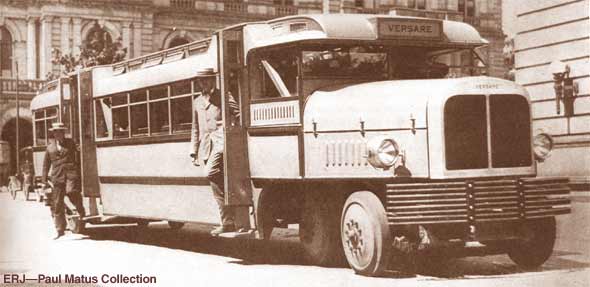|
May 2000
What Is
It?
by Paul Matus

In the early days of bus
design, transit officials pondered ways to overcome some of the bus'
inherent disadvantages as compared to street railway
cars.
One problem (to this day never fuly
resolved) was the limited seating capacity of buses relative to rail
vehicles. Another is the poorer ride associated with
buses.
A factor in addressing both
problems is the shorter wheelbase and length of buses necessitated by the
need to navigate city streets without the operational advantages of a
fixed guideway, which keeps rail vehicles within a known
pathway.
The requirement that buses have
a rear axle attached inflexibly to the chassis frame also makes the
problem worse, as the rear wheels follow the bus on a different pathway
from the front wheels, limiting buses' turning radius and therefore
overall length. A shorter bus obviously carries fewer
passengers.
In 1925 the Versace
Corporation of Albany, New York, demonstrated this innovative vehicle (or
weird contraption, depending on your point of view) on the streets of New
York's capital city. By building a bus on a railway style frame, and
equipping it with railway type trucks (albeit with 8-inch solid tires
instead of flanged wheels), the company hoped to convince transit
officials that they created the best of both
worlds.
The swiveling front and rear
trucks were said to allow this 44-seat, 38 foot long vehicle to turn
within a circle of only 47-1/2 foot diameter, including body
overhang.
The problem of powering these
swiveling trucks was solved by using electric motors powered by on-board
engines.
Despite its inventors' hopes and
efforts, these buses did not revolutionize highway transportation. Would
it be too cynical to observe that, back in the free enterprise era of
transportation, its failure didn't cost the taxpayers millions?
Both photos Electric Railway Journal.

The Third Rail and The Third Rail
logo are trademarks of The Composing Stack
Inc..
|


